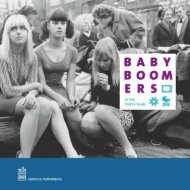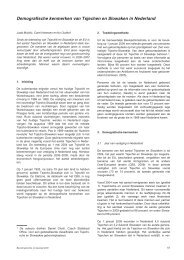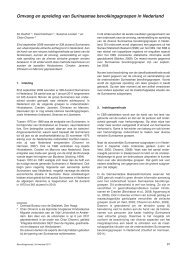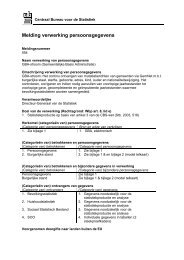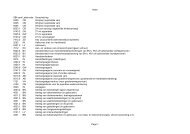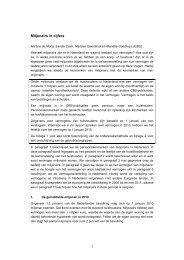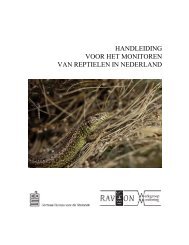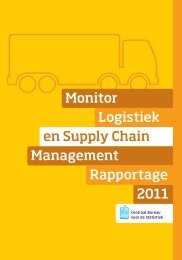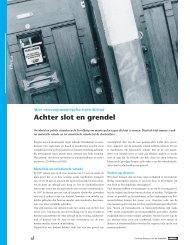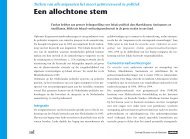Methoden voor de berekening van de emissies door mobiele ... - CBS
Methoden voor de berekening van de emissies door mobiele ... - CBS
Methoden voor de berekening van de emissies door mobiele ... - CBS
You also want an ePaper? Increase the reach of your titles
YUMPU automatically turns print PDFs into web optimized ePapers that Google loves.
In-use compliance programme and <strong>de</strong>dicated measuring programmes<br />
Since 1987, the basis for the recent emission factors of regulated components (CO, VOC, NOx and<br />
PM10) has been the annual in-use compliance programme of TNO Science and Industry. As part of<br />
this programme, every year approximately 150 passenger cars and 30 trucks (including 50 and 10<br />
different types, respectively 10 ) have been tested, primarily using the type approval test cycle.<br />
In addition, supplementary (more practice-oriented) measurements are conducted on the available<br />
vehicles. The vehicles that are tested are selected so that they provi<strong>de</strong> a good reflection of the total<br />
fleet of vehicles on Dutch roads over the years. In this process, the study takes account of vehicle<br />
sales, type of fuels, vehicle class (Euro1, Euro2, etc.) and year of manufacturing. The vehicles were<br />
obtained by writing to the users of the selected vehicle types and asking whether or not they would be<br />
willing to submit their vehicle for a test. The response to this request is relatively low, about 25%, and<br />
has been relatively constant in recent years. As part of the final choice of the vehicles to be tested, an<br />
important criterion is that there is sufficient spread in mileages and regular maintenance. In addition,<br />
both privately owned and leased vehicles are tested. In this way, the tested vehicles reflect the<br />
average usage and maintenance condition of the total fleet of vehicles in the Netherlands.<br />
When they are submitted for testing, the vehicles are subjected to an ECE type approval test, after<br />
which the measurement values are compared with the type approval values for the rele<strong>van</strong>t vehicle<br />
(how high were the emissions of this type when the official type approval took place?) and with the<br />
applicable emission norms. The vehicles that did not pass the test were adjusted and measured again.<br />
In recent years there has been a sharp <strong>de</strong>cline in the number of cars that don’t comply to the existing<br />
norms. On average petrol fuelled cars always comply, for diesel cars this is the case to a lesser<br />
<strong>de</strong>gree.<br />
For the purpose of calculating the emissions from passenger cars TNO uses the measured emission<br />
factors before any maintenance is conducted. As a result, poorly tuned and/or poorly maintained<br />
vehicles are also inclu<strong>de</strong>d in the emission calculation.<br />
During the course of time the emphasis of the in-use compliance programme has moved more and<br />
more to map out real-worls emission performances and not the execution of Euro type approval test<br />
cycles on new vehicles. This is to prevent the un<strong>de</strong>restimation of the real vehicle emissions.<br />
VERSIT+ warm basic emission factors (BASw)<br />
Since 2005, TNO Environmental Studies and Testing (TNO EST) uses the VERSIT+ 11 Traffic situation<br />
mo<strong>de</strong>l [ref 113: Smit et al, 2007] to calculate the basic emission factors from the emission measurements<br />
database. With the use of VERSIT+ exact emission factors can be calculated for different traffic<br />
situations and scale levels [ref 119 Ligterink, N.E., Lange, R. <strong>de</strong>, 2009]. The emission factors follow from<br />
various analysis fed by different kinds of measuring data.<br />
VERSIT+ LD (light duty) has been <strong>de</strong>veloped for light vehicles, as passenger cars and <strong>van</strong>s, with<br />
which accurate emissions can be predicted of streams of traffic in specific traffic situations [ref 111 : Smit<br />
et al, 2006a, 2007]. For the dsetermination of the basic emission factors (BASw) of light duty vehicles first<br />
the driving behaviour <strong>de</strong>pendance and the statistical varation per vehicle has been investigated. Next<br />
the results have been used in a mo<strong>de</strong>l with 42 light duty categories for each of the 5 emission<br />
components. The resulting mo<strong>de</strong>l separates optimal driving behaviour and vehicle category<br />
<strong>de</strong>pendances.<br />
VERSIT+ HD (heavy duty) [ref: Riemersma, 2004] is used to predict the emission factors of heavy<br />
duty vehicles (lorries, road tractors and buses). For ol<strong>de</strong>r vehicles VERSIT+ HD is used with input<br />
based on European measurement data. These data have been obtained with less realistic tests,<br />
meaning that in some cases only the engine has been tested and in other cases measurements have<br />
been executed with several constant engine loads and engine speeds (rpm). For newer vehicles<br />
(Euro-III – Euro-V) measurement data are available which are closer to the real world practice. These<br />
new data are based on realistic driving behaviour, both from on-road measurements and<br />
measurements on test stands, have been used in a mo<strong>de</strong>l to represent emissions during standard<br />
driving behaviour. The emission factors for buses often originate from test stand measurements with<br />
realistic driving behaviour for regular service buses.<br />
For the <strong>de</strong>termination of the emission factors the PHEM mo<strong>de</strong>l is used which has been <strong>de</strong>veloped by<br />
the Graz University of Technology. The input is, just as for VERSIT+ LD, composed of speed-time<br />
diagrams which make the mo<strong>de</strong>l suiontable for the prediction of emissions in varying traffic situations.<br />
For the Emission Registration emission factors per vehicle class are calculated, specifically for the<br />
Dutch situation.<br />
10<br />
vehicle type = manufacturer + mo<strong>de</strong>l + motor type, for example Ford Escort 1.3 ICL<br />
11<br />
VERkeers SITuatie Mo<strong>de</strong>l Plus, meaning traffic situation mo<strong>de</strong>l plus<br />
31



